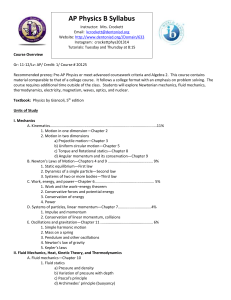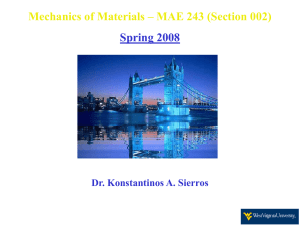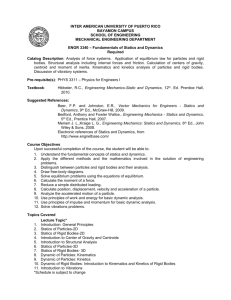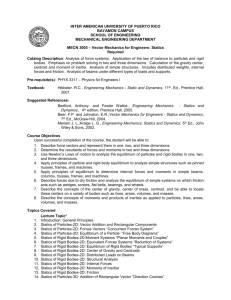Introduction - Engineering
advertisement
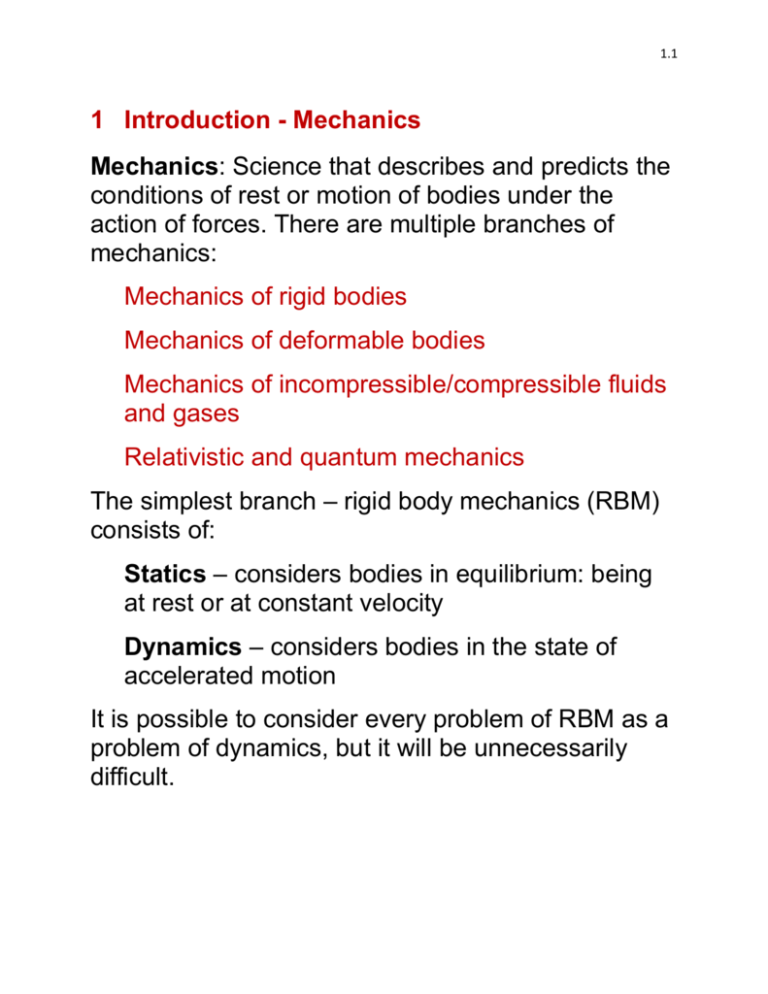
1.1 1 Introduction - Mechanics Mechanics: Science that describes and predicts the conditions of rest or motion of bodies under the action of forces. There are multiple branches of mechanics: Mechanics of rigid bodies Mechanics of deformable bodies Mechanics of incompressible/compressible fluids and gases Relativistic and quantum mechanics The simplest branch – rigid body mechanics (RBM) consists of: Statics – considers bodies in equilibrium: being at rest or at constant velocity Dynamics – considers bodies in the state of accelerated motion It is possible to consider every problem of RBM as a problem of dynamics, but it will be unnecessarily difficult. 1.2 Statics Statics is a foundation of mechanics and strong knowledge of statics is required to study dynamics and mechanics of materials. Basic quantities within the framework of mechanics: Space – describes position of a point in space and geometric properties of bodies (size, shape, etc.) Time – describes succession of events Mass – measures resistance of bodies to a change in velocity (=acceleration) Force – describes action of one body on another. It is a vector quantity. Distinguished as contact or volumetric In Newtonian mechanics, space, time, and mass are independent of each other (not so in relativistic mechanics). Force is not independent and is related to the body’s mass and the way its velocity changes with time. 1.3 The Parallelogram Law for the addition of forces. Two forces acting on a particle may be replaced by a single force, called the resultant. http://tutorial.math.lamar.edu /Classes/CalcII/VectorArithm etic.aspx The Principle of Transmissibility. Conditions of equilibrium or of motion of rigid body will remain unchanged if a force acting at a given point of the rigid body is replaced by a force of the same magnitude and direction, but acting at a different point, provided the two forces have the same line of action. http://yesitsengineering.blogspot. com/2013_08_01_archive.html 1.4 Newton’s Laws First Law. A particle originally at rest or moving in a straight line with constant velocity, will remain in this state, provided the particle is not subjected to an unbalanced force. Second Law. A particle acted upon by an unbalanced force F experiences an acceleration a that has the same direction as the force and a magnitude that is directly proportional to the force. For the particle of mass m: F=ma. https://www.haikudeck.com/ newtons-laws-of-motionjacie-andrews-educationpresentationXkexDkN30k#slide-5 Third Law. The mutual forces of action and reaction between two particles are equal, opposite, and collinear. 1.5 Statics vs. Dynamics Time independent – principles of statics are time independent and acceleration is not present. Hence, only first and third laws are important for statics. Newton’s law of Gravitation: http://philschatz.com/physicsbook/contents/m42143.html 𝑀𝑚 𝐹=𝐺 2 𝑟 Where r is the distance between the bodies of masses M and m. G is a universal constant called constant of gravitation. Weight of the particle (W). Gravitational force F exerted by Earth on a particle of mass m. 𝑊 = 𝑚𝑔 Where 1.6 𝑀 𝑚 𝑓𝑡 𝑔 = 𝐺 2 ~9.81 2 = 32.2 2 𝑅 𝑠 𝑠 Idealizations Particle is a mass of negligible size. Allows maximum simplifications, when the shape and size of the body don’t matter. Rigid Body is a body of fixed, underformable shape. Allows substantial simplifications, when changes of shape of the body don’t matter. Precise calculation of real-world deformations is complex. Concentrated force is a load acting at a point as opposed to a distributed force. Examples: Earth, bike, tennis ball hits racquet. Note: Every idealization should be evaluated, since one level of idealization can be appropriate for the same body in one case and not appropriate in another case. 1.7 Units Every mechanical quantity or an algebraic combination of mechanical quantities has units. Carrying out units throughout calculations is important: • Incorrect units are often related to incorrect answer (but not necessarily vice versa). Typically, units-related error is very large. • Tracing incorrect units might help with finding error – at certain step there can be a mismatch between units – lack of homogeneity (guesswork in choosing equations, adding or missing equation’s elements). Note: Incorrect units are considered an error, despite having a correct answer. 1.8 Systems of Units SI (Systeme International) = Metric = International: • Basic units: L(meter), T(second), M(kilogram). • Derived units: F(newton=𝑁 = 𝑘𝑔∗𝑚 𝑠2 ). Note: W = mg, with m usually given in kg. U.S. Customary = British = FPS (foot-poundsecond): • Basic units: L(foot), T(second), F(pound). • Derived units: M (slug= 𝑙𝑏∗𝑠 2 𝑓𝑡 ). Note: When force is given in pounds there is no need to multiply it by g. 1.9 SI Prefixes and Units Used in Mechanics 1.10 Unit Conversion 1.11 Numerical vs. Symbolic Numerical solution: Answer is found of a number and at times it seems easier to calculate it with the use of a calculator. However, it will require consistent check for units’ homogeneity - all terms should have same units/dimensions and it should be checked before crunching numbers. Numerical answer is problem specific and subject to accuracy of results being lower than accuracy of data due to a round-off. Symbolic solution: Answer is found in form of a formula with much deeper perception of dependencies. Since the symbolic answer is general it is possible to re-use it, unlike the numerical answer. Generally symbolic is more powerful! 1.12 General Procedure for Analysis • Read the problem. Make sure to correlate every given fact to studied, while not adding your own facts (anecdotally!). • Draw necessary diagrams. • Apply relevant principles in mathematical form. • Solve necessary equations algebraically as far as practical, then, making sure they are dimensionally homogeneous, use a consistent set of units and complete solutions numerically. Report the answer with no more significant figures than the accuracy of the given data. • Study the answer with technical judgment and common sense to determine whether or not it seems reasonable. • Review the solution and think of other ways to obtain it. • Try to solve problem as neatly as possible – it helps to see general picture and to avoid regretful mistakes. 1.13 Numerical Accuracy The accuracy of the solution depends on two items: 1. Accuracy of data 2. Accuracy of computations The solution can’t be more accurate than the less accurate of the two items. Example: Loading of a structure is known to be 75,000 lb with a possible error of 100 lb. Relative error: 100 𝑙𝑏 = 0.0013 = 0.13% 75,000 𝑙𝑏 Which means that the accuracy in solution (such as computing reaction in supports) can’t be greater than 0.13%. If the computation gives 14,322 lb, the possible error is (0.13% of 14,322~20 lb), which means that there is no point in recording all the digits from the computation. Rather the answer should be recorded as 14,320±20 lb. Note: In most engineering problems the data is seldom known to accuracy greater than 0.2%


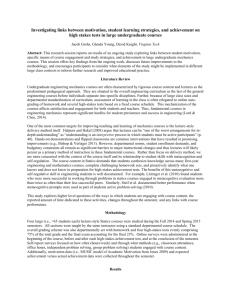
![Engineering Mechanics I [Statics]](http://s3.studylib.net/store/data/008805445_1-fddee1395c8a6c2be807e9dc261d739a-300x300.png)



